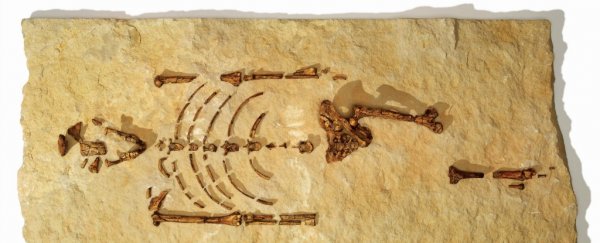It's not every day that researchers crack a case this cold. Lucy, the iconic hominin found in present-day Ethiopia, died 3.18 million years ago. Her cause of death has remained a mystery since her remains were first discovered in 1974.
But a new study published Monday in the journal Nature claims to pin down, for the first time, precisely how and why Lucy died. According to the study authors, she fell from a tree.
"Given the severity of the fractures, it is likely that the impact occurred on a hard surface, perhaps the dry bed of the channel itself," the researchers write in their paper.
Some other archaeologists, including Tim D. White, whose findings of ancient hominin remains in Africa helped illuminate the early stages of human evolution, aren't quite sold.
In fact, they're pretty convinced that the paper is utterly wrong.
Rather than the result of a fall while she was alive, White says the cracks in Lucy's bones emerged long after she passed away - something that happens to thousands of bones that get buried and shuffled around in the Earth's soil for millions of years.
"This may be the first time that such routine fossil damage has been interpreted as evidence of tree dwelling and death by falling," White told Business Insider.
"For good reason. If palaeontologists were to apply the same logic and assertion to the many mammals whose fossilised bones have been distorted by geological forces, we would have everything from gazelles to hippos, rhinos, and elephants climbing and falling from high trees."
The problem appears to have been pretty straightforward, said White: the study authors simply failed to look at the other fossils at the site.
"These authors make no effort to test the alternative hypothesis that these cracks and other breaks were made during the processes of fossilisation and erosion," said White.
Instead, they went straight to the clinical literature for an example of what the break would have looked like in a person, he said.
"When you go to the clinical literature for your analogy … you're confined to a single cause, because we know what happens when humans fall off the top of buildings or fall from windows," William Kimbel, the director of the Institute of Human Originsat Arizona State University, told Business Insider. "There's only one explanation: breakage due to trauma."
And that's almost certainly not what happened to Lucy, said Kimbel.
"I've worked in Eastern Africa for a long time and at fossil sites … like the one where Lucy is from for a long time," Kimbel told Business Insider.
"And I know from my own experience that the type of damage that Lucy's bones exhibit is extremely common in animals that range from hare to hippo. It is ubiquitous. We would not interpret that hares and hippos are falling out of trees."
John Kappelman, the study's lead author and a professor of anthropology at the University of Texas at Austin, told Business Insider that his team did in fact look at plenty of other bones at the site.
But since most fossils get cracked as the result of fossilisation and erosion, White said, "the authors' obligation was to unequivocally demonstrate that the cracks in the bones were made around the time of death rather than during fossilisation".
So we put the question to Kappelman, and asked if he'd indeed tested that alternative hypothesis - that these breaks were made as the fossil got rustled around in the soil instead of by a fall. Kappelman said "Thirty-some years of working in this field has done that for us."
He agreed that the majority of the breaks to Lucy's skeleton happened as the result of regular fossilisation and erosion. "The easy criticism is to say, 'Oh other fossils look like this.' We agree. We put that straight up in the paper," said Kappelman.
But he and his team chose to hone in on one "specific kind of break", said Kappelman. "These are the kinds of breaks that are documented in the clinical literature and what they are is a high energy break."
Kappelman added, "We're not saying that these breaks couldn't have happened through fossilisation, but we looked at these and we said, we think they deserve an explanation."
This article was originally published by Business Insider.
